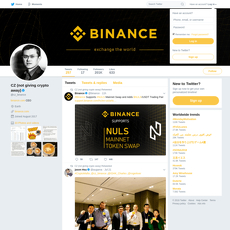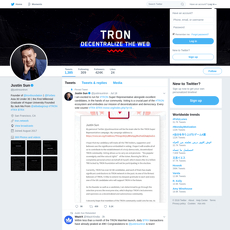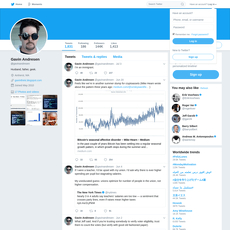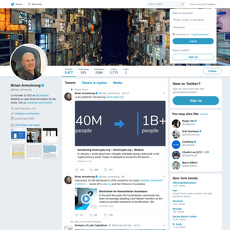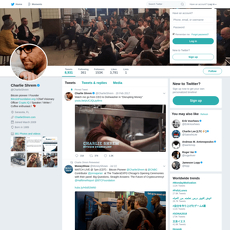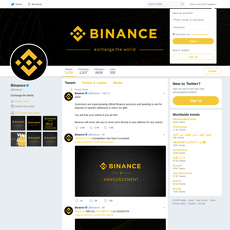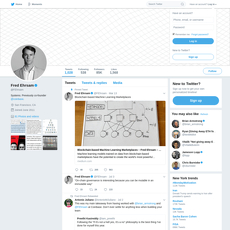notsofast Review
notsofast
twitter.com
notsofast (@notsofast) Review Guide: Everything You Need to Know + FAQ
Does following @notsofast actually make you smarter about crypto—or just more distracted?
I’ve spent years sorting signal from noise on Crypto Twitter. In this guide, I’ll lay out what you can really get from following @notsofast, how to use his content without FOMO, and the quick checks I use to judge any crypto voice. No hype, no hand-holding—just practical value.
By the end, you’ll know whether he belongs on your curated list, how to pull value from his tweets, and what pitfalls to avoid. I’ll also answer the questions people ask the most so you leave with clarity.
Crypto Twitter is a trap if you let it be
Crypto Twitter can be smart, funny, fast—and brutal on your attention and bankroll if you treat every hot take like alpha. Here are the pain points I see over and over:
- FOMO-led entries: You see a thread, rush in, and end up buying the wick. Behavioral research shows fear of missing out pushes impulsive decisions and regret-prone risk-taking (Przybylski et al., 2013).
- Overtrading and churn: The more you trade on noise, the worse your odds. Classic data on retail shows excessive trading typically underperforms (Barber & Odean).
- Confusing narratives with signals: Attention can move prices in the short term, but attention isn’t a thesis. Investor attention and social sentiment do matter (Da, Engelberg & Gao; Kraaijeveld & De Smedt), yet they cut both ways.
- Scattered portfolios: Five “quick” ideas become 25 bags you don’t really understand. Now your plan is whatever your feed says next.
Hot takes are easy. Edge comes from turning information into a process you can repeat—especially when the feed is loud.
Real talk: following smart people can help, but only if you use their perspective to sharpen your own plan—not replace it.
Here’s what you’ll get from this guide
- Clear expectations: What @notsofast brings to the table (and what he doesn’t).
- A simple playbook: How to turn tweets into smart watchlists and decisions without chasing pumps.
- A credibility checklist: A reusable way to vet any crypto account fast.
I’ll keep it practical, with real examples and easy filters you can actually use on a busy day.
Who this is for
- Traders who want context and timing without copy-trading strangers.
- Miners who care about incentives, cycles, and when narratives find hashpower.
- Analysts and builders who track attention shifts and want to avoid launching into headwinds.
- Curious learners who prefer seasoned perspective over moon-post roulette.
Quick disclaimer
Nothing here is financial advice. There’s no affiliation with @notsofast. Treat every tweet—including mine—as an opinion until your data agrees. Your capital, your rules.
Ready to see whether this follow actually earns a slot on your curated list? In the next section, I’ll show you who @notsofast is, what he talks about, and how his posting style fits different market phases—so you can decide in minutes, not months.
Who is @notsofast? Snapshot and context
@notsofast is one of those rare Crypto Twitter accounts that’s been around for multiple cycles and still sounds grounded. Think: altcoin and mining veteran who posts seasoned takes on market structure, risk, and how narratives actually move money. He isn’t chasing clout with “buy now” calls—he’s pointing you toward how to think, when to wait, and where the traps usually sit.
“Patience is a position.”
If your feed is a constant drip of FOMO, his tweets feel like a cold shower. Expect threads when the market heats up, laconic reminders when it cools, and a steady bias toward survival over style points. That’s not sexy—but it’s how accounts last through 70% drawdowns.
What he talks about
His focus rotates with the market, but the spine stays the same: context over calls. Here’s what consistently shows up in his feed, with examples of how it helps:
- Market structure and cycles: He frames action in terms of liquidity, breadth, and rotations.
Example: When majors sprint and small caps lag, he’ll flag rotation risk instead of screaming “altseason confirmed.” That’s the nudge to check breadth metrics and wait for confirmation. - Narratives (not tickers): He tracks themes—L1 vs. L2, restaking, AI, privacy, miner revenues—and how attention migrates.
Example: Rather than shill one AI token, he’ll highlight how AI hype usually overextends first-movers, then trickles into infra plays. That’s your prompt to build a watchlist by category, not by ticker. - Mining and incentives: Occasional notes on hardware payback, hash dynamics, and how miner behavior bleeds into price and sentiment.
Example: Around difficulty spikes or halving windows, he’ll contextualize miner sell pressure—useful for timing patience vs. aggression. - Risk management reminders: Take profits into strength, size sanely, stop copy-trading.
Why it matters: Overtrading wrecks returns. A well-cited study of retail accounts found that higher turnover correlates with lower performance (Barber & Odean, 2000). His feed is basically an antidote to that behavior. - Community observations: He reads sentiment without worshiping it—spotting the shift from curiosity to greed to cope.
Example: If every reply is “wen moon” and engagement spikes on low-float microcaps, he’ll remind you that liquidity exits faster than it enters.
It’s a steady map of where attention is and where it might go next, without pretending timing is easy.
Posting style and frequency
- Straightforward and candid: Short takes, clear threads, and replies that sand down hot takes. There’s humor and humility in the mix, which helps when the market is melting or melting up.
- Cycle-sensitive cadence: More active when volatility spikes and narratives rotate; quieter when the right move is to wait. That’s a feature, not a bug—it keeps you from force-trading chop.
- Format mix:
- Threads for frameworks and cycle context
- Quick replies to reality-check hype
- Occasional quote-retweets to spotlight better data or smarter angles
In other words, you won’t get daily “alpha drops.” You’ll get timely context when it matters and silence when noise is expensive.
Who benefits most from his feed
- Altcoin traders who want to understand narratives and timing instead of chasing candles
- Miners who care about incentives, hardware trade-offs, and how network economics feed into price
- Analysts and researchers who map attention flows and build category watchlists
- Builders timing launches around liquidity, sentiment, and user attention
- Process-oriented learners who prefer risk-aware thinking over “instant alpha”
Quick note on the tone: he’s not here to babysit your trades. He’s here to keep you from blowing up your account while the market writes the real story. That’s why his posts pair well with your own on-chain checks, liquidity scans, and volume breadth—less “what to buy,” more “how to not get trapped.”
So if he’s not handing you signals, what’s the actual edge you can pull from his feed, day after day? In the next section, I’ll show how to turn his posts into concrete frameworks you can use—without FOMO, and without guesswork.
Value you can expect from following @notsofast
You won’t get spoon-fed trades. You’ll get mental models that help you avoid the dumb stuff and position for the smart stuff. His posts push you to think in cycles, watch liquidity, and recognize when narratives have fuel—or when they’re just noise.
“Edge is what’s left after you strip out hype, hope, and hurry.”
He’s not trying to be the loudest person in the room. He’s trying to be the one who sticks around when the music stops. That mindset is worth more than any single “alpha” call.
For traders
I use his commentary as a trigger to build plans, not to copy moves. Here’s how that translates into real, practical value:
- Turn opinions into watchlists: If he notes attention rotating to L2s, I build a list (e.g., OP, ARB, MNT), then track catalysts (governance votes, token unlocks, roadmap milestones). I’ll tag charts with event dates so I’m not trading blind.
- Map narratives to data: Narratives are cheap; confirmation is not. I sanity-check with:
- Funding rates and open interest (e.g., on CoinGlass) to avoid buying into crowded longs.
- Sector volume and TVL drift (e.g., on DeFiLlama) to see if users are actually showing up.
- Social dominance (e.g., Santiment) to catch blow-off attention spikes that often precede pullbacks.
- Plan entries/exits like a pro, not a hero: I’ll pre-write two to three scenarios (A/B/C) with invalidation levels. If price rips 20% on nothing, I pass and set alerts for structure retests. When price drifts into my zone, I scale in small and scale out into liquidity.
- Avoid chasing—on purpose: Academic work shows that retail tends to overtrade and underperform by chasing recent winners (Barber & Odean, 2000; 2001). I adopt a simple rule: if a coin is up ~80% in 48 hours, I’ll wait for a reset or skip it. Process beats FOMO.
- Think in probabilities, not predictions: His tone nudges you away from “will” and toward “if/then.” That’s backed by behavioral research—structured decision-making reduces bias and improves outcomes (Kahneman & Tversky). I’ll size positions at a fraction of my risk budget (often sub-Kelly) when the setup is narrative-heavy but data-light.
Example I actually use: If he posts, “BTC dominance looks tired; second-tier L1s usually catch a bid—don’t call it a new paradigm,” I’ll:
- Pull up BTC.D and set alerts beneath recent highs.
- Build a basket watchlist (e.g., SOL-ecosystem, AVAX-ecosystem) and track 7D vs 24H relative strength to avoid late entries.
- Confirm with stablecoin inflows and perp premiums; if funding is already frothy, I wait.
For miners and infrastructure folks
You’ll see the business side of block production through a market lens, not just hashboards and firmware. That perspective helps with budgeting, hedging, and knowing when to press or pause.
- Mining incentives in context: Comments about difficulty trends, halvings, or fee markets remind me to forecast cash flow beyond spot price. I’ll check hashprice (e.g., Luxor’s index) to see real-time revenue per TH/s and decide: run, curtail, or upgrade.
- Hardware trade-offs made sane: When hype says “upgrade now,” he often points to risk. I’ll model J/TH improvements against power costs and expected difficulty growth. If S19s still make sense at my kWh, I won’t rush into S21s during peak prices.
- Network economics feed sentiment (and vice versa): Miner stress and capitulation can mark meaningful moments. Indicators like hash ribbons have historically flagged recovery windows, though they’re not gospel. I treat them as situational awareness—useful, not deterministic.
- Real hedging talk, not wishful thinking: If pressure is rising post-halving and he hints at prudence, I’ll explore forwards or options to stabilize revenue, or lock energy via PPAs. Staying solvent is the alpha.
For builders and analysts
The real value: early reads on where attention is going and when it’s likely to fade. That’s gold for roadmaps, launches, and research bandwidth.
- Narrative early-warning system: If he flags momentum around restaking, DePIN, or AI tokens, I’ll open a new research thread and track engagement half-life. Social activity leading price is documented in multiple studies on crypto and attention (e.g., Garcia et al., 2014; Mai et al., 2018). I want data that it’s more than a weekend trend.
- Timing launches to attention windows: When he hints that liquidity is clustering on Solana, I consider shipping a Solana-first path or a cross-chain bridge earlier. I’ll align PR with conference cycles (ETHGlobal, TOKEN2049) and set KPIs like “social share of voice” and “first-week retention,” not vanity clicks.
- User behavior > tech purity: If he notes friction points users hate (KYC surprises, slow bridges, gas spikes), I translate that into backlog items. Attention is fragile—fix the thing that makes people bounce.
- Research triage that saves time: His market-cycle framing helps me kill weak angles quickly. If TVL and active wallets aren’t trending with the story, I park it and re-allocate analysis to where metrics are actually moving.
What you should not expect
- No guaranteed calls: You’ll get perspective, not “buy now” posts.
- No hand-holding: He nudges you toward building your own process. You still have to chart, test, and verify.
- No shortcuts: Sometimes silence is the signal—when risk is skewed, waiting is a position.
- No immunity from mistakes: He’s human. Treat every tweet as an input, not a verdict.
One last thing I always ask myself after reading a strong thread: Is the thesis timestamped, falsifiable, and aligned with real data—or is it just a great story? That simple check keeps me honest.
Curious how I separate credible voices from clever talkers—without falling into bias or hero-worship? I’m about to share the exact framework I use, step by step. Want to see what makes the cut?
Is he credible? How I vet any crypto voice (including @notsofast)
On crypto Twitter, authority is cheap and receipts are expensive. My rule is simple: trust slowly, verify always. That includes @notsofast.
"Trust, but verify." — a reminder that saves more capital than any “alpha.”
Track record and receipts
I don’t judge by vibes. I look for timestamped footprints and a willingness to revisit them. Here’s how I check anyone—fast:
- Timeline scan: Use Twitter Advanced Search. Example: from:notsofast since:2020-01-01 until:2021-01-01. Then add keywords like “alt season”, “mining”, or “risk” to see how takes shifted through a cycle.
- Receipt trail: Open key threads with Thread Reader and see if there are follow-up tweets months later. Does he note what aged well and what didn’t?
- Wayback check: If a post was influential, throw the URL in the Wayback Machine to see if edits or deletions changed the context.
- Reply accountability: Filter for replies (filter:replies) to see if he engages with criticism or just farms praise.
What I generally see with @notsofast: long-run participation across multiple cycles, a recurring focus on risk, and reminders to think in probabilities—not certainties. That’s the right lane for someone who’s been around.
Quick score (0–2 each):
- Timestamps: Are there dated, specific views? (0 = none, 2 = clear and frequent)
- Follow-ups: Are old takes revisited? (0 = never, 2 = yes, with context)
- Balance: Wins and misses owned? (0 = only victory laps, 2 = honest postmortems)
Why it matters: Research shows attention-grabbing narratives can distort decisions. Individual investors often chase what’s loud and underperform as a result (Barber & Odean, 2008). Receipts fight that by anchoring you in reality, not noise.
Conflicts and disclosures
Everyone has incentives. I want them on the table.
- Bio and pinned posts: Look for affiliations, advisory roles, or ongoing partnerships.
- Tweet-level tags: Search their timeline for “ad”, “sponsored”, “disclosure”, “I hold”, or “paid”. Example search: from:notsofast (ad OR sponsored OR disclosure).
- Link trails: Click through links. Referrals and tracking parameters are fine if disclosed. Hidden incentives are not.
- Ask plainly: If something moves your wallet, ask in replies, “Do you hold this? Any paid relationship?” Silence or hostility is data.
For @notsofast, I treat every opinion as opinion unless there’s a clear disclosure. That’s how I handle any account, veteran or not. If a thread leans promotional, I wait for third-party confirmation before I move a satoshi.
Consistency and skin in the game
I’m allergic to fair-weather experts. I look for people who show up in booms and boredom, and who actually do things in the ecosystem.
- Principles over predictions: Do they repeat core rules—risk sizing, patience, degen limits—across cycles?
- Participation: Mining, running nodes, building tools, funding grants, or testing networks. Tweets are cheap; participation isn’t.
- Learning loops: Do they share mistakes and how they adapted? Survivors of 2018 and 2022 usually carry those scars with humility.
With @notsofast, a recurring mining lens and risk-first attitude are what I expect to see. That kind of consistency is a positive signal. And if he changes his stance, I want to see the reasoning, not a pivot in silence.
Why it matters: False news spreads faster than true news on Twitter (Vosoughi et al., Science, 2018). Consistent, principled voices cut through that because they don’t need hype to be heard.
Red flags to watch with any influencer
- Guaranteed outcomes: Phrases like “risk-free,” “can’t lose,” “guaranteed 10x.” Markets don’t do guarantees.
- All-in language: “I sold everything for X,” “max long,” “zero downside.” This is entertainment, not process.
- Hidden shills: Undisclosed links, stealthy referrals, or “just sharing” posts that line pockets.
- Low-liquidity timing: Sudden hype for tiny caps right before illiquid moves. If replies are locked or critics get blocked, extra caution.
- Deleted misses: A spotless timeline often means a messy one got cleaned. Use archives or quote retweets to reconstruct context.
- Engagement farms: Giveaways and “retweet to win” floods. A distraction machine rarely makes you money.
30-second pump smell test: If a post makes your heart race, your sizing should get smaller, not bigger. Emotional spikes are where bad decisions live.
A 10-minute credibility check you can run today
- Open their top five threads from different market phases (bear, chop, bull) and read for consistent principles.
- Search for their biggest miss and see how they handled it. Honest postmortems are gold.
- Check disclosures, then cross-check links for hidden incentives.
- Skim replies from dissenters. Healthy accounts don’t sanitize criticism.
- Write one sentence: “This account’s edge is X, and its blind spot is Y.” If you can’t answer, you don’t know what you’re following.
I’m not looking for perfection. I’m looking for process. If the process is sound, the feed can be useful—even when the market isn’t.
Now here’s the real unlock: once you’ve vetted a voice, how do you turn their tweets into smart, patient action without letting FOMO torch your bankroll? Want a clean, 3-step filter I actually use?
How to use his tweets without FOMO: a simple playbook
Good tweets can sharpen your edge—or push you into dumb, rushed trades. I use a simple system to turn commentary into clear choices without spinning my account like a roulette wheel.
“If a tweet makes your heart rate jump, step away from the button. Good trades feel calm.”
My 3-step filter: Capture → Context → Confirm
1) Capture — Save the idea, not the hype.
- Bookmark the tweet, paste the link into a notes doc, and list any tickers, catalysts, or on-chain metrics mentioned.
- Real sample: he flags “rotation into old-school PoW alts when majors cool.” I log: narrative = PoW rotation; tickers = KAS, RVN; catalysts = fee spikes, hashrate shifts; data to watch = fees, active miners, liquidity.
- Why: ideas disappear fast in a noisy feed. Capturing removes urgency and buys time for a proper check.
2) Context — Sanity-check with data and your own thesis.
- Price and volume: higher highs/higher lows? Volume above 20-day average?
- Relative strength: vs BTC and vs sector index, not just USD.
- On-chain or network: active addresses, fees, TVL, hashrate, dev activity.
- Liquidity: spreads, depth, reputable venues. If a $10k market order moves price 2%+, size accordingly or pass.
- Catalyst calendar: token unlocks, vesting cliffs, mainnet dates, conference windows.
- Real sample: tweet hints at “miner stress.” I check Hashrate Index for hashrate trends and margins, and a simple hash-ribbon proxy (miner capitulation can precede bottoms). If the data doesn’t line up, idea gets parked.
3) Confirm — Act only when your setup appears, not someone else’s.
- Define the trigger: e.g., daily close above prior range high + higher low retest; or ETHBTC reclaiming a key weekly level.
- Define invalidation: the price level that proves your idea wrong (structure-based, not “how much it hurts”).
- Define risk: 1R before entry. If stop is 6%, size so a stop-out = 1R loss you can live with.
- Real sample: if a thread points to a mid-cap L2 narrative, I wait for RS vs BTC to turn up and OI to cool on Coinglass before touching spot. No trigger, no trade.
Tools and alerts that help
Keep the signal, mute the noise.
- X (Twitter) Lists: build a “Context” list with accounts you trust (add @notsofast). Read that list first, not the main feed.
- Muted terms: “100x”, “send it”, “bottomed”, “guaranteed”, “alpha leak”. Emotional language nudges bad decisions.
- Notifications: set alerts for his threads, not every post. If you can’t filter threads, use a second account that only follows your curated list.
- TweetDeck/Advanced search: from:notsofast min_faves:200 to surface posts with traction. Skim replies for pushback and extra context.
- TradingView alerts: put levels on assets mentioned. The price should trigger you—not the tweet.
- Notes doc (Notion/Sheets): columns I use: Date, Link, Narrative, Tickers, Data to Check, Trigger, Invalidation, Outcome. Review weekly.
- Thread saving: use Thread Reader or bookmarks + monthly export. Revisit when the market cools.
- Automation: Zapier/IFTTT can send your X bookmarks into Notion with the tweet URL and timestamp. Zero copy-paste friction.
Risk rules to keep you safe
Start small, scale if right.
- Test size first: open at 0.25–0.5R. If thesis confirms, scale; if it wobbles, you’re out with a scratch.
- No leverage on narratives: narratives can gap. Spot only until you’ve got multiple confluences and tight invalidation.
- Separate buckets: long-term holds in one wallet, trades in another. Different rules. No mixing.
- Pre-trade checklist (must hit 4/5): data alignment, liquidity ok, clear catalyst or structure, defined invalidation, 2R+ potential. Miss one? Wait.
- Guardrails: max 2 new narrative trades per week; max 3R total risk on at any time; no adding risk during event weeks (unlocks/Fed/major listings).
- Cool-off rule: if you feel urgent, add 24 hours or require a daily close. Most “can’t-miss” moves are traps.
Why I’m strict: hyperactive trading underperforms. In equities, active retail traders underperformed by ~6.5% annually due to costs and timing errors (Barber & Odean, 2000). Different market, same human brain. Want receipts?
- Trading Is Hazardous to Your Wealth (SSRN)
- FOMO, social media, and impulsive behavior (Computers in Human Behavior)
Helpful resources
- On-chain and flows: DeFiLlama (TVL, fees, narratives), Glassnode Studio (free dashboards), Coin Metrics community.
- Derivatives and sentiment: Coinglass (funding/OI), Laevitas (options, skew).
- Unlocks and supply: TokenUnlocks, CryptoRank unlocks.
- Dev momentum: Electric Capital Developer Report, GitHub Trending.
- Mining and network health: Hashrate Index, CoinWarz.
- Market structure: TradingView (alerts, lists), Cryptowatch.
- Attention checks: Google Trends for narrative keywords; if attention is peaking before price structure, be careful.
- Notes system: Notion or templates for a trade journal. Simple beats fancy.
You’ve got the playbook. Want the quick answers everyone asks—like whether he’s “legit,” how often he posts, and how to get value without guessing? That’s where I’m headed next…
FAQ: People also ask about @notsofast
If you’re trying to figure out whether @notsofast deserves space on your feed, this quick-hit FAQ gives you fast, practical answers—no fluff.
Is @notsofast “legit” and worth following?
Short answer: yes—if you’re after context over hype. He’s been around for multiple cycles, tends to favor risk-aware framing, and focuses on principles rather than “buy now” calls. That mix helps you cut through noise.
Real-world example: during frothy weeks when memecoins or narrative coins rip vertically, he often reminds followers to respect liquidity, rotate thoughtfully, and avoid overexposure. I’ve used that framing to build watchlists, wait for confirmation (funding, volume, and structure), and only scale when my invalidation is clear. Results: fewer FOMO entries, more planned trades.
Why this matters: Well-known research shows attention-driven trading often underperforms because people overtrade when excited. If you use perspective to slow down, you’re already ahead.
- Study: “Trading Is Hazardous to Your Wealth” (Barber & Odean) — SSRN
- Study: Crypto attention and price co-movement — PLOS ONE
Does he do paid promotions or sponsored calls?
Always assume opinion unless a tweet is clearly labeled. Look for obvious disclosures like #ad, partner, sponsored, ref, or affiliate. If you’re unsure, ask once, then move on if it’s not clear. Your capital deserves that discipline.
- Quick check: use X/Twitter search like from:notsofast (ad OR #ad OR partner OR sponsored OR ref OR affiliate)
- Know the rules: FTC disclosure basics for influencers — FTC guide
Bottom line: treat every post as one input. If there’s any conflict, it should be disclosed. If it isn’t, act like it’s not—and verify independently.
What’s the best way to get value from his feed?
Think “frameworks, not signals.” Here’s a simple process that’s worked well for me:
- Put him on a curated list alongside a handful of macro, on-chain, and quant accounts. This makes trend-spotting easier and reduces noise.
- Read replies—he often adds nuance below the main post, and discussions in the thread reveal how the crowd is interpreting a narrative.
- Bookmark or save key threads, then translate each idea into a checklist: catalyst, liquidity, structure, invalidation.
- Tie ideas to data: watch volume, open interest/funding, on-chain flows, and relative strength across peers before you act.
How often does he tweet and what’s the tone?
Frequency tends to track market temperature. Expect more commentary when narratives heat up and quieter periods when patience is smarter than action. The tone is straightforward with some humor mixed in, but the core is consistent: protect downside, respect cycles, and don’t force trades.
Can beginners follow along?
Yes—just treat it like a practice gym, not a signal service.
- Start with tiny size or paper trades until your thesis-building and risk rules are solid.
- Keep a one-pager glossary for terms like “funding,” “narratives,” “market structure,” and “invalidation.”
- Log your ideas and outcomes in a simple sheet: what you thought would happen, why, what actually happened, and what you’ll change next time.
You’ll learn faster by tracking your own reactions to his posts than by copying any single take.
Want the straight yes-or-no on whether he belongs on your feed—and a tight action plan to avoid rookie mistakes? That’s exactly what I’m sharing next.
Is following @notsofast right for you? My verdict
Short take: if you want seasoned context and risk-aware thinking instead of hype, hit follow. You won’t get spoon-fed calls—you’ll get perspective you can plug into your own plan.
What I appreciate most is the focus on cycles, narrative timing, and survival. You’ll often see reminders to take profits when alt sectors run hot and to be patient when markets turn quiet. That balance is useful if you’ve ever felt pushed into trades by timelines screaming “now or never.”
Context > calls. Process > predictions. Risk first.
There’s good reason to build around that mindset. Research consistently shows that attention and social buzz can pull retail into bad timing:
- All That Glitters (Barber & Odean) shows attention-grabbing assets draw in buyers at the worst moments.
- Preis et al. (Nature Scientific Reports) and Kristoufek link spikes in search/attention with volatile moves—great for awareness, risky for chasing.
Following someone who routinely stresses patience and position management is a healthy counterweight to that bias.
Who should click the follow button
- Traders who want narrative timing and risk frameworks—not signals. If you build watchlists and wait for your setup, his context helps.
- Miners and infra folks who value macro market read-throughs and incentives talk beyond chart lines.
- Builders/analysts who track attention rotation to plan launches, research, or coverage shifts.
- Curious learners who prefer nuance over “number go up” threads and aren’t looking to copy-trade.
Who should probably pass: if you want guaranteed calls, hand-holding, or high-frequency trade alerts, this isn’t that feed.
Quick action plan
- Follow smart, not loud: add him to a curated “signal” list. Mute generic pump terms so you only see what matters.
- Notifications: turn on alerts for threads, not every tweet. Threads usually hold the frameworks.
- Archive ideas: save key posts into a notes doc with three lines: “thesis,” “what would disprove it,” and “data to track.”
- Confirm with numbers: pair any narrative with data before you act:
- Funding rates to avoid crowded longs/shorts
- Token Terminal for protocol revenue/users
- Messari or Coin Metrics for network trends
- Size tiny first: test the idea in paper or with a sliver of your normal position. If it behaves as expected, scale. If not, cut quickly.
- Pre-commit your exit: write the invalidation price/time in advance. A simple pre-mortem reduces bias (HBR—Premortem).
Final take
I’m keeping @notsofast on my list. He’s strong on cycle awareness, tempered on risk, and useful for filtering noise into a workable plan. Pair his perspective with your own data checks and a written process, and you’ll likely avoid the classic “see it, chase it, regret it” trap that social feeds can trigger.
Want more straight-shooting reviews like this? I post them here: cryptolinks.com. Stay patient, protect your bankroll, and let process do the heavy lifting.
CryptoLinks.com does not endorse, promote, or associate with Twitter accounts that offer or imply unrealistic returns through potentially unethical practices. Our mission remains to guide the community toward safe, informed, and ethical participation in the cryptocurrency space. We urge our readers and the wider crypto community to remain vigilant, to conduct thorough research, and to always consider the broader implications of their investment choices.


